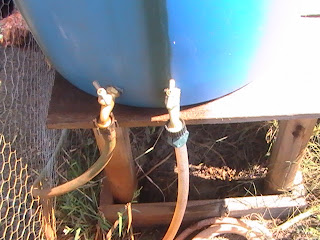 |
| Buckeye hens- notice the rose comb? |
When we decided to transition over to a sustainable flock of Buckeye chickens we looked at our current poultry system and found it lacking. Rare breed birds are farely costly and well.... rare. We love the concept of free range chickens, but there is a large population of hawks on our farm. The hawks think that mobile chicken pens are like kitchen cabinets or the refrigerator in your kitchen - it's where you store your food until you're ready to eat it. So this year when we ordered Buckeye chicks and hatching eggs, we made the decision to renovate our first hog shed into a chicken coop. So we gutted the hog shed. Cleaned it all out. The building has three separate sections. One we finished for my mom's Auracauna chickens - Green legs the rooster and his party colored harem girls. The other side is for the Buckeyes. The third section is yet unfinished. I'm planning to close in 2 sides and add chicken wire to the third this spring for the chicks we hope to hatch in our incubator.
We did all these improvements to the building so we decided we would put what we know about feeders and waterers together to automate the chicken chores as much as possible. We invested in 2 oil catch pans - the plastic one you use to catch the nasty old oil out of your truck when you change the oil and 6 bolts with washers and nuts. We already had a couple of lidded plastic buckets. Brian's little zip roater made fast work of cutting out holes along the bottom edge of the bucket sides for the feed to flow out. Then a few holes drilled in the bottom for the bolts, slap on the pans, tighten down the nuts and VOILA! A chicken feeder that will hold enough feed for about 4 or five days for full grown birds... much longer for chicks. So after successfully engineering feeders we turned our efforts to self-waterers. All the waterers commercially available were expensive and too small to really reduce workload much. So once again we took our experience with cattle, sheep, goats, horses, pigs and various watering setups and put it all together.
 |
| Closeup of the spigots on the holding barrel. |
We have been using 55 gallon plastic barrels as water reservoirs for our hog waterers for years and we had a barrel that wasn't in use. Brian added two taps and set it up on a sturdy stand about 30 inches from the ground. Two sections of hose and gravity carry the water from the barrel to the water cups. We had those laying around too. They were left over from our short experiment with goat keeping. The drinking cups work with a float shut off and are just the right size so several birds can drink at once. We just mounted them to the side of the new coop with a couple of screws. Of course in the winter the watering system will need to be drained. We'll be using rubber pans during the winter so we can empty out the ice daily. For now we water about once a month.
 |
| Hens coming up to the drinking fountain. |
We moved the chicks into the coop as soon as they were ready to come out of the brooder. Three dozen or so fuzzy Buckeye chicks and about the same number of Auracaunas with a few wing feathers looked pretty small in all that space.
Now they are full grown and magnificent. The buckeyes are some of the handsomest birds I have ever raised. The hens are lovely dark russet red and the roosters with their iridescent green/black tail feathers are striking. The hens should start to lay nice brown eggs next month. Then in the spring we'll start hatching chicks. I love spring!




No comments:
Post a Comment